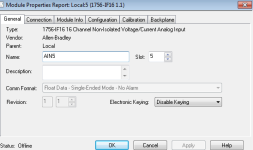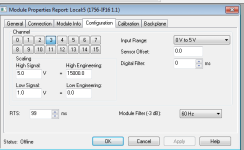Hello,
Why do I have two different readings between transmitter and PLC
We have a flow meter sending 4-20 HART to PLC AI card attached with configuration shown in attachment.
The meter display is showing about 900 scfm, but the online live PLC value is showing about 1600 scfm.
Configuration is with a 250 ohm resistor on the AI inputs terminal block.
The loop current matches the PLC value not the meter display.
Is it possible the PLC AI card is not setup for 4-20mA HART?
When I send a 4-20mA only signal to the PLC, PLC matches.
Thank you


Why do I have two different readings between transmitter and PLC
We have a flow meter sending 4-20 HART to PLC AI card attached with configuration shown in attachment.
The meter display is showing about 900 scfm, but the online live PLC value is showing about 1600 scfm.
Configuration is with a 250 ohm resistor on the AI inputs terminal block.
The loop current matches the PLC value not the meter display.
Is it possible the PLC AI card is not setup for 4-20mA HART?
When I send a 4-20mA only signal to the PLC, PLC matches.
Thank you








